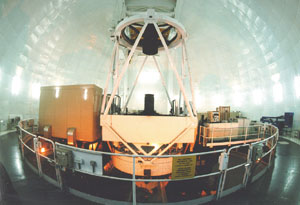Superconducting tunnel junctions have been developed as photon-counting spectroscopic detectors for ground- and space based astrophysical research. Arrays of tantalum-based junctions have now reached a state of maturity such that serious space-based applications can be considered over a range of wavelengths.

Experimental astrophysics is all about detecting photons from distant objects, and over an increasingly wide range of wavelengths. Progress in the field advances hand in hand with advances in photon-detection technology, particularly superconductors.
The absorption of a photon in a superconductor is followed by a series of fast processes that involve the breaking of Cooper pairs by energetic phonons created by the hot electrons produced as the atom relaxes after the initial photoabsorption. The result of this cascade is that the photon’s energy is converted into a population of free charge – quasiparticles – in excess of any thermal population.
For typical transition metals, this conversion process ranges from nanoseconds (niobium) to microseconds (hafnium). At sufficiently low temperatures (typically about an order of magnitude lower than the superconductor’s critical temperature) the number density of thermal carriers is very small while in a superconductor, such as tantalum, the initial mean number of free charge carriers created is much greater.
Limiting resolution


The quasiparticles produced through photoabsorption can be detected by applying a DC potential across two such films separated by a thin insulating barrier, forming a superconducting tunnel junction (STJ). This potential bias favours the transfer of quasiparticles from one film to the other via quantum mechanical tunneling across the barrier. The detector signal is therefore represented by the current developed by this tunnel process.
After initial tunnelling, a quasiparticle can, moreover, tunnel back, contributing many times to the overall signal before it is lost. This also boosts performance.
The overall limiting resolution for a STJ depends on the characteristics of the superconductor, but it is predictable. Figure 1 illustrates this resolution for a number of elemental superconductors.
Observations at X-ray wavelengths…


High-resolution X-ray spectroscopy provides the ability to determine the electron and ion temperatures, the electron density and the relative abundance of the elements, as well as establishing the degree of thermal and ionization equilibrium in a hot plasma.
While the measurement of the intensity of the hydrogenic and helium-like lines from the same element is an important ion temperature indicator, it is the ability to resolve the satellite lines that can determine the key characteristics of the X-ray-emitting plasma in a model-independent manner.
Figure 2 shows the response of a tantalum STJ to the large complex of lines (the Fe-L complex) around 1 nm, which is expected to be radiated from an optically thin plasma having a temperature of approximately 107 K. In this example, continuum emission has been suppressed for clarity. As the majority of lines are easily resolvable with such a tantalum STJ, measurement of the relative intensity of the lines from the same ion enables the temperature to be uniquely determined. In addition, through the relative intensity of lines from different elements, their relative abundances can be established.
Note that the intensity ratio of resonance lines from different ions of the same element, together with line centroids, allows one to deduce either the degree of ionization equilibrium or possibly the distance to the object via the determination of the redshift. A high spectral resolution is required for such observations. This resolution can be achieved using a tunnel-limited tantalum STJ but is impossible with conventional solid-state devices.
…and at ultraviolet and optical wavelengths
In optical and ultraviolet spectroscopy, a high resolution normally implies a resolving power of 104. From figure 1 it is clear that none of the classical superconductors forming the basis of current STJs under development (based on niobium, tantalum, aluminium, molybednum or hafnium) could achieve such resolving power.
In fact, a superconducting critical temperature well below 100 mK is implied to achieve such resolving power, leading to the development of STJs based on such elemental superconductors as rhodium. Of course, things are not quite this simple, with the temporal characteristics associated with the production of the free excess charge carriers being a function of the critical temperature, while phonons have wavelengths that are significantly larger than the thickness of the film. Thus such low temperature superconductors may respond significantly slower.
Given that the resolution of a typical STJ based on tantalum is not appropriate for high- or even medium-resolution spectroscopy, what are the alternative key attributes of such a device for optical/ultraviolet astronomy?
Timing precision (below 10 ms), coupled with the broadband spectral capability, may make this the ideal spectrophotometer. Objects such as pulsars and flare stars may be ideal objects to observe with narrowfield small arrays. In addition, the efficiency at ultraviolet wavelengths, coupled with a large-format array (a panoramic detector), may allow for the development of an efficient broadband imaging spectrometer to determine the low-resolution spectra of faint objects, allowing for deep field surveys.
Such surveys could allow the determination in a single exposure of the broadband spectra and possibly therefore the redshift (and thus age) of all objects through the measurement of the Lyman edge and the Lyman emission lines – the “Lyman forest”.

Owing to redshift, the Lyman edge is close to the optimum performance for a tantalum-based STJ with an efficiency of some 70% and a resolution of 20 nm.
However, it is clear that STJ devices based on lower-temperature superconductors such as hafnium would allow the clear evaluation of redshift. Of course, the response of the STJ in the ultraviolet is particularly attractive for future space-based astronomy missions.
Current performance


Tantalum-based STJs build on earlier work with niobium. The predictability of both tantalum and niobium devices (cf. figure 1) give some confidence in the ultimate successful development of lower-temperature elemental superconducting tunnel junctions, such as those based on hafnium.
Figure 3 illustrates the measured spectra from a tantalum STJ forming part of a 6 ¥ 6 array illuminated by monochromatic radiation of various wavelengths. The array is shown in Figure 4, where each device was 25 ¥ 25 mm and consisted of two films each 100 nm thick. Only those photons absorbed in the base film, separated from top film and substrate events by their distinct signal risetime, are shown. Typical resolutions of 0.015 nm (3.5 eV) at 2.4 nm (~500 eV) were measured and are indicated in figure 1.
At optical and ultraviolet wavelengths, where the photon energy is small, spatial effects, which degrade the response below 0.5 nm, are unimportant. Here it is rather that the signal is low, so the signal-to-noise ratio is the dominant factor governing the resolution.
At these wavelengths the photons enter the detector through the substrate, which can be either sapphire or magnesium fluoride, depending on the short wavelength cut-off required. The theoretical efficiency of a tantalum device deposited on a sapphire substrate with this mode of illumination is high. All photons are absorbed in the high-quality epitaxial tantalum base film. Efficiencies of 70% from 200 – 600 nm are expected, limited at short wavelengths by the cut-off of the sapphire substrate, and these have been experimentally confirmed.
To illustrate the broadband response of this type of detector, figure 5 shows the charge spectrum from a single tantalum-based device illuminated with optical light via a grating monochromator. This response ranges from 296 to 1183 nm – from the ultraviolet to the near-infrared.
Precise determination
Not only are the various orders well resolved, but the charge output as a function of wavelength can be precisely determined leading to a high wavelength linearity. This allows wavelength resolution to be determined across a broad waveband, and this is shown for both tantalum- and niobium-based devices in figure 1.
The astronomical capabilities of this unique detector have now been demonstrated. Figure 6 shows the light curve of the Crab pulsar obtained from a 6 ¥ 6 pixel optical array installed in early 1999 at the William Herschel Telescope, La Palma.
All photons are detected individually from this pulsar, a spinning neutron star with a period of 33 ms some 6000 light-years away, and their energy (wavelength) and arrival time recorded. This opens up the pulse phase spectroscopy of exotic objects, and demonstrates the feasibility of the technique on space-based missions, covering a range of wavelengths – from 0.5 nm to 2 mm (approximately 0.5-2500 eV).





